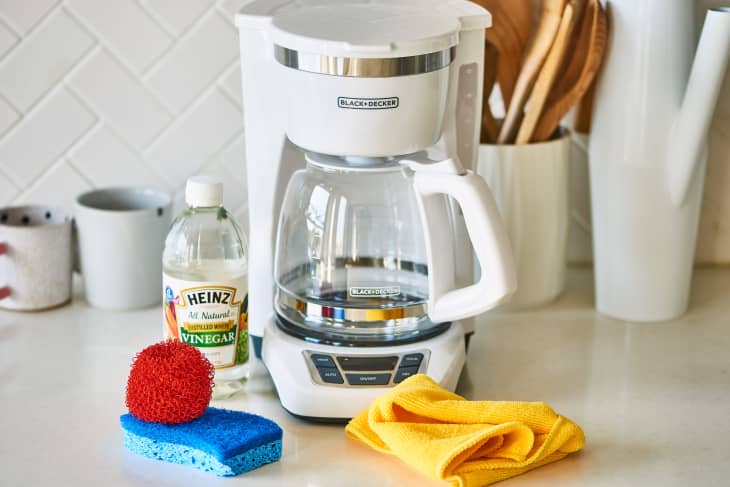How to Clean a Coffee Maker

If a mug of coffee is a morning (or afternoon) essential in your home, then it’s important to stay on top of cleaning your machine. How often you clean yours ultimately hinges on how much you use it. The more water you run through it, the higher likelihood you’ll want to clean the machine on a routine basis.
If you’re not the type to mark the calendar for chores, look out for a few telltale signs that your coffee maker needs some love: By the time your coffee starts to taste bitter and, for lack of better terms, a bit funky, you’ll know it’s time to clean things up. But gross-tasting coffee isn’t the only indicator: Evidence of hard water buildup or mineral deposits in the carafe or the inside of the machine is also a sign it’s time to clean your coffee maker.
The process won’t just result in a better-tasting brew—it will also protect the integrity of your machine, preventing stains and removing stubborn hard water spots. And while it might sound laborious, cleaning your coffee maker is actually relatively easy. In fact, you probably already have all the cleaning tools you need on hand at home.
Time to give your brew method an upgrade? Here’s everything you need to know about how to clean a coffee maker.
Things to Know Before You Start
Angela Bell and Georgia Dixon, Grove Guides with Grove Collaborative, offer up a few safety warnings. It may seem obvious, but never submerge the entire appliance in your sink or dishwasher. You could irreversibly damage the coffee maker or injure yourself in the process. And always use care and watch out for broken glass when you’re cleaning the glass carafe!
To prevent pathogens from accumulating in your coffee maker, practice good hygiene. Bell recommends emptying out water from the machine’s reservoir after every use, since standing water can attract bacteria and pests. Also, avoid leaving a coffee filter with wet grounds in the coffee maker—this is a recipe for moisture and mold.
How to Clean a Coffee Maker
Even if you limit the moisture your coffee maker is exposed to, you’ll still need to clean it regularly (assuming you enjoy the taste of your coffee as is). Here’s how to clean a coffee maker, step by step:
1. Empty the carafe and grounds.
By now, you probably know not to leave grounds (or old, stagnant coffee) in your machine. But if you’re cleaning right after you used the machine, go ahead and empty it. Rinse the carafe clean, and make sure to dump out any coffee grounds remaining in the filter.
2. Make a cleaning solution.
Make a cleaning solution of one part water to one part vinegar. You’ll want enough of the solution to fill up half of your carafe, so use that to measure it out.
3. Pour the solution.
Carefully pour the entirety of the solution into the water chamber, to its full capacity.
4. Run a half brew cycle.
Start a brew cycle. Midway through it, turn off your coffee maker. Then, set a timer for an hour and let the solution sit in the carafe, doing its work.
5. Run the rest of the brew cycle.
After the hour is up, let the brew cycle finish.
6. Run a fresh water cycle.
Once the brew cycle is finished, pour out your cleaning solution and add fresh water to the chamber, without vinegar. Run a second brew cycle this way, repeating twice. Make sure to allow your machine to cool between brews.
7. Clean the exterior and carafe.
After wiping down the exterior of your coffee maker with a clean rag, wash the carafe and filter basket in hot, soapy water. Then, reassemble the machine once all the parts are dry!
Is a descaling solution better than vinegar?
If your coffee maker is particularly grimey, Bell recommends opting for a descaling solution, which uses ingredients like citric acid to help break down mineral deposits. But vinegar should be a perfectly fine solution for your run-of-the-mill cleaning. Not only is it a natural alternative to chemical-ridden cleaners; it’s also much less expensive (and doesn’t require a trip to the store, since you probably already have some vinegar in your home).
How do I clean my coffee maker without vinegar?
Of course, a descaling solution is an option. Baking soda is another accessible, inexpensive way to clean your coffee maker if you don’t want to use vinegar (or if you just don’t have any around). Just mix a cup of warm water with ¼ cup baking soda, run it through a single cycle in the coffee maker, and flush the system with hot water twice until the water runs clear. Good as new!